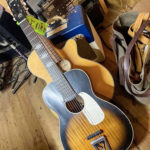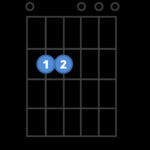The Gsus chord guitar, often written as Gsus, is a captivating and versatile chord that adds a unique flavor to your playing. Whether you’re a beginner strumming simple songs or an experienced guitarist exploring new sonic textures, understanding and utilizing the Gsus chord can significantly enrich your musical palette. This guide delves into the essence of the Gsus chord, breaking down its theory, variations like Gsus2 and Gsus4, and practical ways to play it on your guitar.
Understanding the Suspended Chord Family: What is Gsus?
The term “sus” in chord names stands for “suspended.” Suspended chords are neither major nor minor. They create a sense of harmonic tension and anticipation by replacing the third of a major or minor chord with either a major second (sus2) or a perfect fourth (sus4) interval. This suspension creates a momentarily unresolved sound that often resolves beautifully to a major or minor chord, adding emotional depth to music.
The Gsus chord, in general terms, refers to either the Gsus2 or Gsus4. Without further specification, “Gsus” often implies either of these variations, and context usually clarifies which one is intended. Let’s examine each variation to understand their distinct characteristics.
Gsus4 Chord: The Suspended Fourth
The Gsus4 chord is built by taking a G major chord (G-B-D) and suspending the major third (B) up to a perfect fourth (C). Therefore, the notes of the Gsus4 chord are G, C, and D.
- Notes: G – C – D
- Intervals: Root (G), Perfect Fourth (C), Perfect Fifth (D)
The Gsus4 chord possesses a bright, open, and slightly unresolved quality. It’s commonly used to create a feeling of anticipation before resolving to a G major chord.
Gsus2 Chord: The Suspended Second
Conversely, the Gsus2 chord is formed by taking a G major chord and suspending the major third (B) down to a major second (A). The notes of the Gsus2 chord are G, A, and D.
- Notes: G – A – D
- Intervals: Root (G), Major Second (A), Perfect Fifth (D)
The Gsus2 chord has a gentler, more mellow, and airy quality compared to the Gsus4. It often evokes a sense of peacefulness or reflection and can be used effectively in folk, pop, and acoustic music.
Playing Gsus Chords on Guitar: Shapes and Positions
Now, let’s get practical and explore how to play both Gsus4 and Gsus2 chords on the guitar. You can find various voicings and positions for these chords across the fretboard, but we’ll focus on some common and useful shapes.
Gsus4 Guitar Chord Diagrams
Here are a couple of popular ways to play the Gsus4 chord on guitar:
Open Position Gsus4:
This is a common and easy-to-learn voicing for beginners.
Alt text: Gsus4 open chord diagram for guitar, showing finger positions on the fretboard.
To play this open Gsus4 chord:
- Place your index finger on the 1st fret of the B string (C note).
- Leave the G string, D string, A string, and low E string open.
- Strum all six strings.
Barre Chord Gsus4 (5th string root):
This is a movable barre chord shape that allows you to play Gsus4 and other sus4 chords up and down the neck.
Alt text: Gsus4 barre chord diagram for guitar, 5th string root, illustrating finger placement for a movable chord shape.
To play this barre Gsus4 chord:
- Barre your index finger across all six strings at the 3rd fret.
- Place your ring finger on the 5th fret of the A string (D note).
- Place your pinky finger on the 5th fret of the D string (G note).
- Strum all six strings.
Gsus2 Guitar Chord Diagrams
Let’s look at some common shapes for the Gsus2 chord on guitar:
Open Position Gsus2:
This voicing is also relatively easy and sounds beautiful in open tunings or folk arrangements.
Alt text: Gsus2 open chord diagram for guitar, demonstrating a simple finger position for beginners.
To play this open Gsus2 chord:
- Place your index finger on the 2nd fret of the A string (A note).
- Leave the G string, D string, B string, and high E string open.
- Strum the top five strings (avoiding the low E string for a cleaner sound).
Barre Chord Gsus2 (6th string root):
Similar to the Gsus4 barre chord, this Gsus2 shape is movable and rooted on the 6th string.
Alt text: Gsus2 barre chord diagram for guitar, 6th string root, showing a movable barre chord form for different neck positions.
To play this barre Gsus2 chord:
- Barre your index finger across the 5th fret of the A, D, G, B and high E strings.
- Place your ring finger on the 7th fret of the D string (D note).
- Strum the top five strings (A string down to high E string).
Tips for Using Gsus Chords in Your Music
Gsus chords are incredibly versatile and can be used in various musical contexts. Here are some tips to integrate them effectively:
- Resolution: Gsus4 chords often sound great leading into a G major chord. Try playing Gsus4 – G to hear this classic resolution.
- Transition: Both Gsus2 and Gsus4 can create smooth transitions between other chords, adding harmonic interest.
- Texture: Use Gsus chords to add a unique texture to your chord progressions, especially in folk, pop, and indie music.
- Dynamics: Experiment with strumming or fingerpicking Gsus chords with different dynamics to create varied moods and emotions.
Conclusion: Embrace the Gsus Chord
The Gsus chord guitar is a valuable addition to any guitarist’s chord vocabulary. By understanding its theory, exploring different voicings, and experimenting with its application, you can unlock new sonic possibilities and add depth and emotion to your guitar playing. Practice these Gsus chord shapes, experiment with them in your songs, and discover the unique character they bring to your music.


